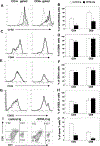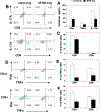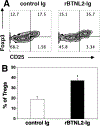In vivo administration of recombinant BTNL2-Fc fusion protein ameliorates graft-versus-host disease in mice
- PMID: 30389093
- PMCID: PMC6368466
- DOI: 10.1016/j.cellimm.2018.10.008
In vivo administration of recombinant BTNL2-Fc fusion protein ameliorates graft-versus-host disease in mice
Abstract
Although hematopoietic stem cell transplantation (HSCT) has been widely used in the treatment of many diseases, graft-versus-host disease (GVHD) remains a major complication after allogeneic HSCT. Butyrophilin-like 2 (BTNL2) protein has been reported to have the ability to inhibit T cell proliferation in vitro; its ability to inhibit T cell responses in vivo has not been determined. We show here that in vivo administration of recombinant BTNL2-IgG2a Fc (rBTNL2-Ig) fusion protein ameliorates GVHD in mice. This is related to the ability of rBTNL2-Ig to inhibit T cell proliferation, activation and Th1/Th17 cytokine production in vivo. Furthermore, rBTNL2-Ig treatment increases the generation of regulatory T cells. Our results suggest that rBTNL2-Ig has the potential to be used in the prevention and treatment of patients with GVHD.
Keywords: Activation; Butyrophilin-like 2; Graft-versus-host disease; Hematopoietic stem cell transplantation; Regulatory T cells; T cell proliferation.
Copyright © 2018 Elsevier Inc. All rights reserved.
Conflict of interest statement
Figures





Similar articles
-
BTNL2-Ig Protein Attenuates Type 1 Diabetes in Non-Obese Diabetic (NOD) Mice.Adv Healthc Mater. 2019 May;8(9):e1800987. doi: 10.1002/adhm.201800987. Epub 2019 Mar 18. Adv Healthc Mater. 2019. PMID: 30884196 Free PMC article.
-
TIGIT-Fc alleviates acute graft-versus-host disease by suppressing CTL activation via promoting the generation of immunoregulatory dendritic cells.Biochim Biophys Acta Mol Basis Dis. 2018 Sep;1864(9 Pt B):3085-3098. doi: 10.1016/j.bbadis.2018.06.022. Epub 2018 Jun 28. Biochim Biophys Acta Mol Basis Dis. 2018. PMID: 29960041
-
Inducible Costimulator Gene-Transduced Bone Marrow-Derived Mesenchymal Stem Cells Attenuate the Severity of Acute Graft-Versus-Host Disease in Mouse Models.Cell Transplant. 2015;24(9):1717-31. doi: 10.3727/096368914X684592. Epub 2014 Sep 8. Cell Transplant. 2015. PMID: 25203502
-
Regulatory T cells and IL-17-producing cells in graft-versus-host disease.Immunotherapy. 2011 Jul;3(7):833-52. doi: 10.2217/imt.11.51. Immunotherapy. 2011. PMID: 21751953 Review.
-
Alloreactivity as therapeutic principle in the treatment of hematologic malignancies. Studies of clinical and immunologic aspects of allogeneic hematopoietic cell transplantation with nonmyeloablative conditioning.Dan Med Bull. 2007 May;54(2):112-39. Dan Med Bull. 2007. PMID: 17521527 Review.
Cited by
-
Emerging strategies for treating autoimmune disease with genetically modified dendritic cells.Cell Commun Signal. 2024 May 7;22(1):262. doi: 10.1186/s12964-024-01641-7. Cell Commun Signal. 2024. PMID: 38715122 Free PMC article. Review.
-
BTNL2 promotes colitis-associated tumorigenesis in mice by regulating IL-22 production.EMBO Rep. 2023 Mar 6;24(3):e56034. doi: 10.15252/embr.202256034. Epub 2023 Jan 11. EMBO Rep. 2023. PMID: 36629012 Free PMC article.
-
The Role of B7 Family Molecules in Maternal-Fetal Immunity.Front Immunol. 2020 Mar 24;11:458. doi: 10.3389/fimmu.2020.00458. eCollection 2020. Front Immunol. 2020. PMID: 32265918 Free PMC article. Review.
-
Structural Insights into N-terminal IgV Domain of BTNL2, a T Cell Inhibitory Molecule, Suggests a Non-canonical Binding Interface for Its Putative Receptors.J Mol Biol. 2020 Nov 6;432(22):5938-5950. doi: 10.1016/j.jmb.2020.09.013. Epub 2020 Oct 5. J Mol Biol. 2020. PMID: 32976909 Free PMC article.
References
Publication types
MeSH terms
Substances
Grants and funding
LinkOut - more resources
Full Text Sources

